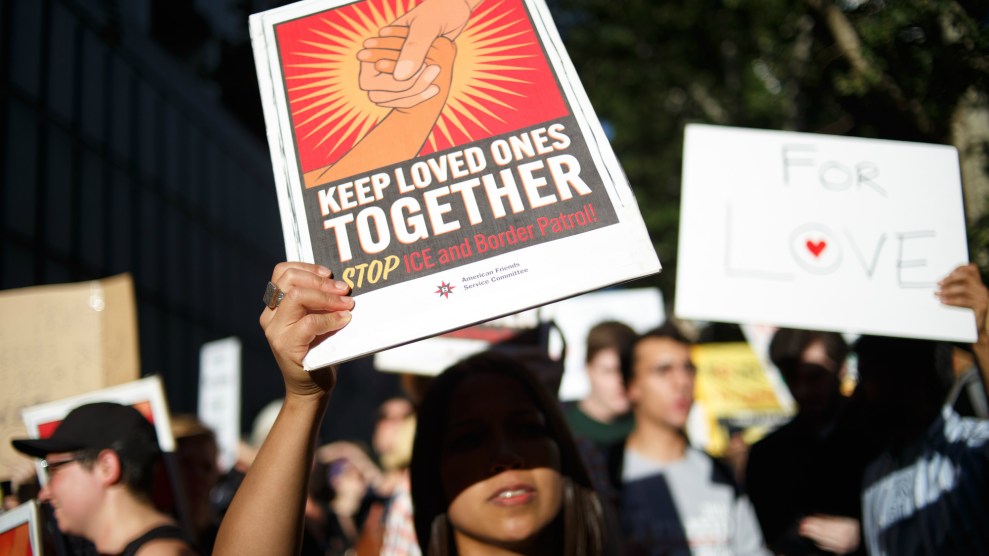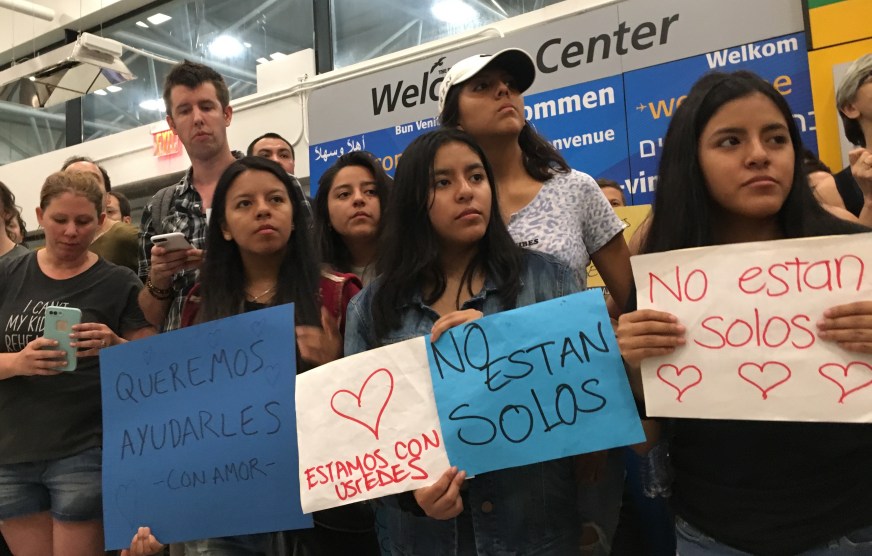They came by the hundreds, rushing to the airport where little kids were being flown in from Texas.
Supporters in New York headed to LaGuardia Airport on Wednesday night to tell these kids that even though they were separated from their parents by other Americans, they were not alone—and they were loved.
Mother Jones’ Mark Helenowski reported at the scene:
“My heart was broken tonight when I was following one of the kids who landed about 8:45 p.m.,” explained Cristina Jiménez, executive director of United We Dream, a national immigrant advocacy group. “He seemed disoriented, and he was really scared. I spoke to him in Spanish, and I told him, ‘I love you. We’re with you. We are here to fight for you.'”
Watch Helenowski’s dispatch from the protest here. Interested in finding out how you can help? I wrote about how to do that here.
Hi, David Beard here, and this week in Recharge I’m profiling people who are working to help others. Justice occasionally prevails, no matter what the headlines say. Recharge is a weekly newsletter full of stories that will energize your inner hellraiser. You can sign up at the bottom of the story.
- Gina Rodriguez does a very Jane the Virgin thing with Emmy promo money. Rather than splashy “For Your Consideration” ads for the Emmys, Jane the Virgin star Gina Rodriguez had another idea. Why not use that money to send an undocumented woman to college? Her studio went for it. And with the help of a Los Angeles nonprofit, Rodriguez offered a scholarship to a Latinx student who plans to attend Princeton University. (Entertainment Weekly)
- Comeback story: From the sea, stars (again). After a mysterious disease decimated more than 80 percent of its population, the purple and orange starfish off Northern California have made an amazing recovery—and adapted to ward off a deadly pathogen. Scientists believe some sort of environmental stress—perhaps warmer water or more acid in the ocean—caused sea stars to become more susceptible to a waterborne pathogen, which spread like the common cold, the San Francisco Chronicle’s Peter Fimrite reports. But since 2013, researchers have found a 74-fold increase in the population of ochre sea stars, giving hope to scientists for other fish and marine animals. The scientists attribute this increase to a preexisting gene passed down among the surviving sea stars. Michael Dawson of the University of California-Merced cautioned that while the sea star’s recovery was “reassuring,” other species may not adapt this fast to the effects of climate change. He put it this way: “The ochre sea star’s resilience is perhaps a small, distant bright light on a pretty stormy sea.” (San Francisco Chronicle)
- They’re 11. They’re composers. And they wowed the New York Philharmonic. Camryn Cowan and Jordan Millar, amid tens of thousands of people in Central Park, heard the classical music they wrote performed by a world-class orchestra. They saw the standing ovation from the stage and learned about the rave review in the New York Times. “I think I have more things ahead of me,” says Cowan, a violinist and pianist who prefers Bob Marley, Beyoncé, and Cardi B to classical music. Cowan and Millar are part of the Philharmonic’s Very Young Composers initiative, a partnership with 15 schools. “Women are sometimes put down in orchestras, or they’re not noticed enough for their great talent,” Cowan says, “so I think that me being onstage is a good change. Other people, other kids or adults—maybe they don’t have this same opportunity. I think we can be inspiring for them.” (New York Times)
- During power failure, seven-year-old designs a winner for Google. If school hadn’t been closed, if the electricity hadn’t been off at home, and if her mom hadn’t stumbled upon a contest due that very day to keep her daughter occupied—well, Sarah Lane-Gomez might not have won a $30,000 college scholarship. Her Falls Church, Virginia, school also received $50,000 in tech funds when she won a Googe 4 Doodle contest for her dinosaur-themed sketch drawn during the “Monster nor’easter” snowstorm in March, DesignTaxi.com reports. Lane-Gomez worked throughout that day on her sketch—and the family took her to Applebee’s for dinner that evening. When power went out there, they went to a nearby burger place to finish the sketch. See the winning image below. (Design Taxi)

Have a Recharge story of your own or a suggestion on how to make this column better? Fill out this form or send a note to me at recharge@motherjones.com. Have a great week ahead and make sure to sign up for the newsletter below.

















